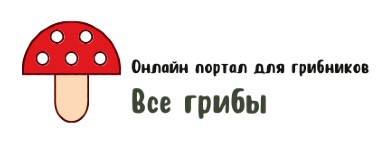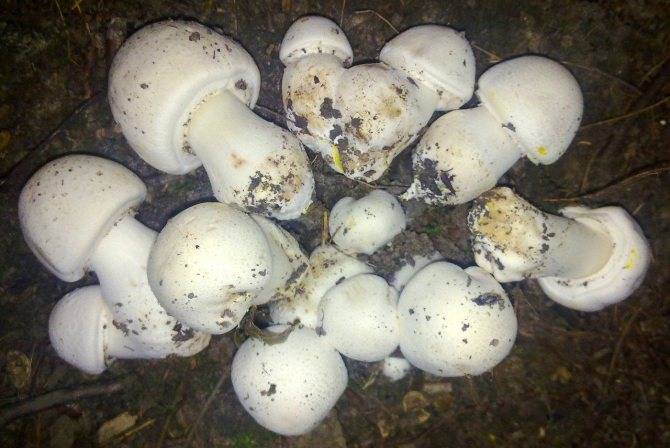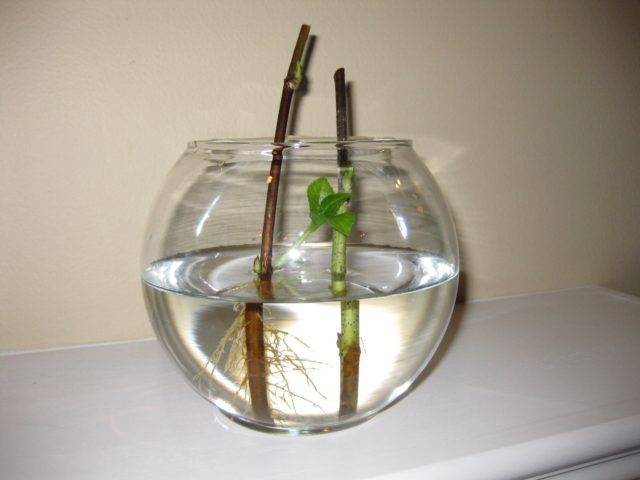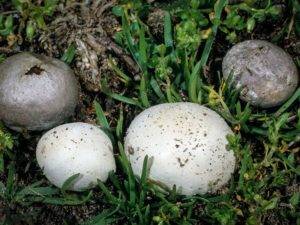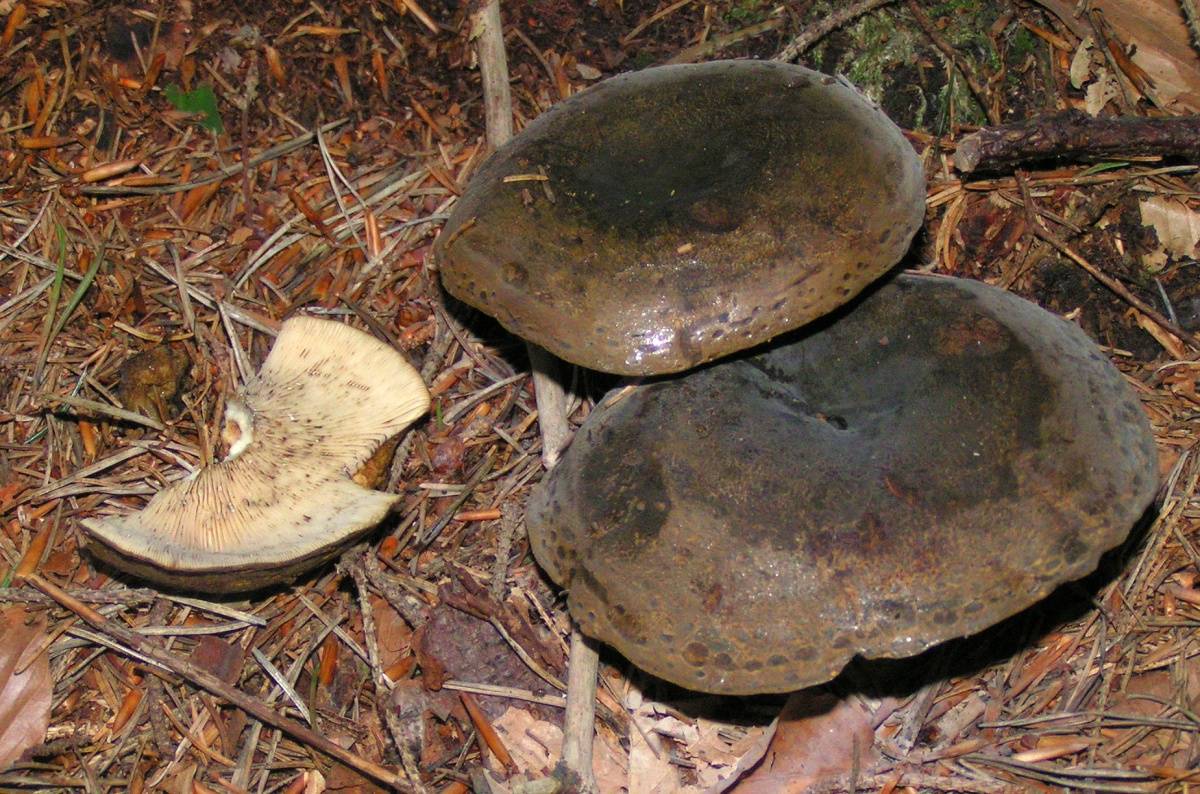Dyer’s puffball, Erbsensteinpilz
It’s not easy to find names of this one in other languages, and many of the common names are not very complimentary, referring to the appearance of the puffball when it opens and turns brown and scungy. Say no more. It appears to be rare in the British Isles, and to prefer southern Europe; with our Mediterranean climate here in South Australia it’s not difficult to find in autumn. I haven’t posted a picture as I wouldn’t want to be responsible for any unfortunate misidentification. I was always told that all fungi/toadstools are poisonous and to avoid them. Good, general safety advice for kids, but what about adventurous natural dyers? Some sources say it’s poisonous, others not, others that it “may be”. Well, I’m not going to eat it anyway, and handle it with care. Regarding the common names, ironic enough that I carried it home in a doggy bag (and not the sort you ask for in a restaurant).
I sliced a portion off one end and made several slits in it rather than cutting it into chunks. Why? To avoid any mess. The section was then simmered for about 40 minutes. The water didn’t take long to turn opaque dark brown. The chunk of fungus was then removed and the yarn dropped in. Half of the skeins immediately took on a dark brown, while the others remained pale. I didn’t bother fishing them out to find out, but just assumed that the mordanted ones were the darker.
About half-an-hour later (maybe less), the water had turned translucent dark yellow, and the skeins dark and light orange, a bit like a dahlia dyebath both before and after an alkaline mordant. This was going to be interesting…
As if those colours weren’t fascinating enough, when they came out of the dyepot there was further transformation. The non-modified skeins, when rinsed, turned shades of chestnut brown. Was this due to oxidisation?
Adding bicarb turned the next pair of skeins a deep plum brown, a colour I’ve never achieved before. Definitely one to repeat, and I’ll be scouring some more yarn later.
Vinegar turned the third pair two shades of honey brown. Like all the other skeins, the shades are deep and strong.
The iron modifier produced two shades of dark brown. And finally the copper modifier, which I’ve only just made and started using. Chestnut brown again, but brighter than the first pair.
I read that the dye is substantive, but using a mordant clearly deepened the colours. They aren’t quite as bright as this in real life, but I’m really not good at colour manipulation. Now, off to wind some more skeins for scouring…
Advertisement
Пизолитус бескорневой (Pisolithus arhizus)
Плодовые тела:
грушевидные или булавовидные, округлые в верхней части или имеющие неправильно шаровидную форму. Плодовые тела, вытянутые в удлиненную ямчатую, разветвленную у основания ложную ножку или сидячие. Толщина ложной ножки от 1 до 8 сантиметров, большая часть ножки скрыта под землей. Спороносная часть в поперечнике достигает 2-11 сантиметров.
Перидий:
гладкий, тонкий, как правило, неровный, бугорчатый. В молодом возрасте ломкий охристо-желтого цвета, затем становится желто-коричневым, красно-оливковым или темно-коричневым.
Глеба:
Глеба молодого гриба содержит большое количество беловатых капсул со спорами, которые погружены в траму – желатинообразную массу. На месте среза плодовое тело имеет зернистую красивую структуру. Созревание гриба начинается с верхней его части и постепенно завершается у его основания.
По мере созревания гриба, глеба распадается на несколько неровных, гороховидных перидиол. Угловатые перидиолы, сначала окрашены в серно-желтый цвет, затем становятся красновато-коричневыми или коричневыми. Созревший гриб приобретает схожесть с экскрементами животных, трухлявыми пнями или полусгнившими корнями. Разрушенные перидиоли образуют пылящую порошкообразную споровую массу. Молодые плодовые тела имеют легкий грибной запах. У созревших грибов, запах неприятный.
Порошок спор:
коричневый.
Распространение:
Пизолитус Бескорневой встречается на дренируемых нарушенных или кислых почвах. Произрастает небольшими группами или одиночно. Предпочитает шахтные овалы, озеленяемые старые карьеры, зарастающие вырубки воль старых дорог и тропинок. Устойчив к очень кислым почвам и к почвам, содержащим соли тяжелых металлов. Плодоносит с лета и до начала осени.
Съедобность:
Одни источники называют гриб съедобным в молодом возрасте, другие не рекомендуют его употреблять в пищу. Некоторые справочники указывают применение гриба в качестве приправы.
Схожесть:
В молодом возрасте данный вид можно принять за Бородавчатый Ложнодождевик.
Замечания: Пизолитус Бескорневой имеет практическое назначение для восстановления лесных насаждений в местах с нарушенными почвами. Образует микоризу с сосной и некоторыми другими породами. В Южной Европе используется в качестве желтого красителя. Выделенный из Пизолитуса Пизостерол обладает противоопухолевой активностью. Редкий вид, внесенный в красные списки Ростовской области, Бурятии и некоторых других стран.
Importance
Forestry
The common pea litter Ling, due to its ability to colonize nutrient- poor and acidic sites, a great ecological importance in reforestation and afforestation of waste heaps and similar locations.
It is also used in nurseries producing a mycorrhiza, its spores are traded for this purpose.
Dye
Use place the peas litter Ling also for dyeing wool, after which the synonymous scientific species name ” tinctorius ” ( Dyer’s ) and the English name ” Dyemaker ‘s Puffball ” (dye manufacturer Puffball ) allude.
Feed value
Although the congregation peas litter Ling is not regarded as edible mushroom, it is estimated as a spice mushroom sauces in the kitchen of some mushroom collectors because of its strong flavor.
Description
initially to , 4-12 cm diameter, 4-25 cm high, irregularly club-shaped, dull white, spotted olive-brown, yellowish brown to dingy brown with age. breaking open and disintegrating at the , releasing the brown powdery spores (see photo above). The is composed of oval , pure white at first, becoming yellowish then dark brown and powdery when mature. Locules mature from the top down and more locules form near the base until almost the entire fruiting body is converted into a powdery mass.
Cross section of P. tinctorius, clearly showing the locules that comprise the gleba. Compare the mature lobules at the top with the younger locules towards the bottom.
Odor: mild when young, but unpleasant with age.Spore print: brown/cinnamonSpores: , with long (up to 1 µm) spines, thick-walled, 7-12 µm.Habitat: single to several, occasionally on ground under hardwoods and conifers; widely distributed; fruiting in spring, summer and fall during wet weather. Edibility: inedible.
Уход
Следует соблюдать следующие условия
- Почва. Выбирать лёгкие плодородные почвы для посадки, нейтральные и слабокислые с хорошей водо- и воздухопроницаемостью; допускается использовать готовые смеси для кактусов. Также можно приготовить субстрат самостоятельно: смешать в равных количествах торфяную почву, песок и дерновую землю, предварительно уложив на дно горшка дренажный слой.
- Освещение и температура. Рекомендуется как можно более яркое освещение, расположение на южной, западной либо восточной стороне дома. Прямые лучи ничем не навредят, наоборот, стимулируют рост и цветение кактуса. Оптимальная температура – комнатная, около 20 °C, выдерживает похолодание до 0 °C.
- Полив и влажность воздуха. Гилоцереус не нуждается в частом поливе. Его достаточно поливать раз в неделю летом и раз в 3-4 недели зимой, использовать дождевую либо отстоянную воду для обеспечения растения необходимыми солями. Главное условие – чтобы перед поливом грунт успел достаточно просохнуть. Влажность воздуха должна быть высокой, около 60%, при необходимости следует опрыскивать кактус из пульверизатора.
- Подкормка. Удобрять можно 2-4 раза за период активного развития растения (с апреля по октябрь), зимой удобрения не требуются. Достаточно готовой смеси для кактусов, фикусов или суккулентов.
- Пересадка. Проводится в весеннее время после цветения. Пересаживают только в случае крайней необходимости (корневая система очень чувствительна). После пересадки некоторое время нужно ограничить полив и подкормку.
Если корни пробиваются через дренажный слой и выступают из дренажного отверстия горшка, пересадка необходима. Если же корням пока достаточно места в прежнем, достаточно заменить верхний слой грунта.
Description
Young Dyeballs look a lot like most other earthballs (and most rocks); they are roughly spherical with a smooth surface dominated by white, yellow, purple, or brown shades. Despite this fact, you can easily identify the mushroom once you pick it up. If you dig up the entire mushroom, you will find it has a stocky root-like base that projects into the ground. The base usually has yellow mycelial threads attached. This combination of a rooting base with yellow mycelium is quite distinctive. Even more distinctive, though, is its messiness. While picking up the mushroom, you probably squeezed it a little. If you did and the mushroom is young and fresh, it’s likely that your fingers are now covered in a sticky tar-like goo. P. arrhizus has a very thin outer skin (which is unusual for earthballs), so its blackish gelatinous filling oozes out when squeezed. This characteristic is unique to Pisolithus, allowing you to quickly figure out the species after you pick it up.
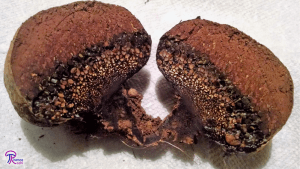
The Dyeball is easily identified by its unique gleba, which features small peridioles embedded in black goo. Also note the root-like base, which is usually covered in yellow mycelium (not visible).
You could stop there, but the most distinctive feature of this mushroom is its interior. When sliced in half (top to bottom), the Dyeball displays a beautiful mosaic pattern in its gleba. At the very bottom, the sterile, root-like base is dark brown to black. Just above that, you can see tiny, whitish to yellowish dots called “peridioles” that stand out against their dark surroundings. The peridioles rest in a cushion of black tar-like material that you can see oozing out all the way to the base. As you move up the mushroom, the peridioles get larger and become roughly pea-sized. The space between the peridioles decreases as they get larger, squashing them into an irregular tessellating pattern. About halfway up the fruiting body (or higher/lower if the mushroom is younger/older), the peridioles start turning black or olive-brown. Each peridiole is a bundle of spore-producing tissue, so the color change indicates the point at which spores begin to form. At the top of the mushroom, the mature spores in the peridioles become cinnamon-brown and powdery. Here, the walls between the peridioles start to break down, leaving an undifferentiated mass of powdery, brown spores at the very top of the earthball.
Once enough mature spores build up, the skin on the top of the mushroom cracks open to reveal the powdery mess. The Dyeball can still produce more spores once this happens because peridioles mature from the top down. At this stage, mushroom growth becomes somewhat erratic, causing the Dyeball to look less and less like a ball. Mature P. arrhizus mushrooms grow up to 20cm across and 5-30cm tall or taller and often end up in strange shapes, such as that of a pile of dung, a tree stump, a top, an enormous molar, etc. This mushroom’s odor becomes fouler as it matures, but starts out as mild to fragrant.
Medicinal properties
Antitumor effects
The triterpene pisosterol (chemical structure shown above) has been shown to have antitumor activity against seven tumor cell lines, especially leukemia and melanoma cells (IC50 of 1.55, 1.84 and 1.65 µg/ml for CEM, HL-60 and B16, respectively) (). The compound has also been shown to induce a monocytic cell-like differentiation of the leukemia cell line HL-60 (). Additionally, a recent in vivo study has corroborated the results. Montenegro et al. () demonstrated that -bearing mice treated with pisosterol had significant tumor growth inhibition rates – 43.0% and 38.7% for mice treated with pisosterol at 10 or 100mg/m2, respectively. However, the liver and kidney suffered what the authors described as a ‘reversible’ damage.
Links
Tom Volk’s Fungus of the MonthMushroom Expert
References
Montenegro RC, de Vasconcellos MC, Bezerra FS, Andrade-Neto M, Pessoa C, de Moraes MO, Costa-Lotufo LV.Pisosterol induces monocytic differentiation in HL-60 cells.Toxicol In Vitro. 2007 21(5):795-800.
Montenegro RC, Farias RAF, Pereira MRP, Alves APNN, Bezerra FS, Andrade-Neto M, Pessoa C, de Moraes MO, Costa-Lotufo LV.Antitumor activity of pisosterol in mice bearing with S18 tumor.Biol Pharm Bull. 2008 31(3):454-7.<Montenegro RC, Jimenez PC, Farias RAF, Andrade-Neto M, Bezerra FS, Moraes MEA, de Moraes MO, Pessoa C, Costa-Lotufo LV.Cytotoxic activity of pisosterol, a triterpene isolated from Pisolithus tinctorius (Mich.: Pers.) Coker & Couch, 1928.Z Naturfors C. 2004 59(7-8):519-22.
What You Should Know
Pisolithus arhizus or Pisolithus Tinctorius is a widespread earth-ball like fungus. This amazing mushroom starts out looking like a tough, walnut- to baseball-sized puffball, but eventually develops into a minor monstrosity that sticks up from the ground like a dusty stump.
Progressively from the top, the whole of the fruitbody turns into a soft mass of brown spore-bearing powder. At maturity, cracks appear in the upper surface and the spores blow away on the breeze or get washed away to new locations in wet weather.
Because it forms mycorrhizas with almost any kind of root, this ectomycorrhizal fungus is frequently used by foresters (and in recent years by gardeners, too) as the basis of a soil inoculant to promote tree and plant growth – particularly in the remediation of areas of degraded or polluted land or formerly clear-felled forest sites.
The black viscous gel is used as a natural dye for clothes. Pisolithus arhizus is a major component in mycorrhizal fungus mixtures that are used in gardening as powerful root stimulators.
Other names: Dead Man’s Foot, Dyeball, Horse Dung Fungus, Perdebal, Bohemian Truffle.
Pisolithus arhizus Synonyms
Lycoperdon arrizon Scop.
Scleroderma arhizum (Scop.) Pers.
Scleroderma tinctorium Pers.
Pisolithus arenarius Alb. & Schwein.
Lycoperdon capsuliferum Sowerby
Polysaccum olivaceum Fr.
Polysaccum pisocarpium Fr.
Pisolithus tinctorius (Pers.) Coker & Couch.
Sources:
Photo 1 – Author: Dušan Vučić (Creative Commons Attribution-Share Alike 4.0 International)
Photo 2 – Author: Dušan Vučić (Creative Commons Attribution-Share Alike 4.0 International)
Photo 3 – Author: TimmiT (Creative Commons Attribution-Share Alike 3.0 Unported)
Photo 4 – Author: Dušan Vučić (Creative Commons Attribution-Share Alike 4.0 International)
Pisolithus arhizus Taxonomy and Etymology
This mushroom was described in 1786 by Italian mycologist Giovanni Antonio Scopoli. Treating it as a puffball, Scopoli gave this fungus the binomial scientific name Lycoperdon arrizon.
In 1801 Christiaan Hendrik Persoon retained (but with an ‘h’) the specific epithet when he included this species with other earthballs in the genus Scleroderma.
From 1928 this fungus was known (and still is in some modern field guides) as Pisolithus tinctorius – that specific epithet referring to its use in dyeing fabrics.
It was not until 1959 that the Dyeball became generally known by its current scientific name, which was proposed by German Stephan Rauschert (1931 – 1986).
The generic name Pisolithus comes from two Greek words: Piso- meaning a pea, and lith meaning a stone, while the specific epithet arrhizus means ‘having no roots’. Pisolithus arrhizus therefore translates to rootless pea-stone.
Edibility and Uses
We’re talking about one of the world’s ugliest mushrooms and you want to eat it? Apparently, some people do eat P. arrhizus when very young, but this is not recommended. Most earthballs are poisonous, so it is likely that P. arrhizus does have some toxins. Additionally, avoiding the group entirely ensures you don’t eat a misidentified earthball.
The Dyeball, as its common name implies, can also be used for dyeing wool. P. arrhizus is counted among the best mushrooms for dyeing and imparts wool with a deep brown to reddish-brown to blackish color. The pigments come from the tar-like gel between the peridioles, so younger Dyeballs work better.,
Ecology and phenology
The common pea litter Ling is a heat- loving mycorrhizal fungus with a wide range of symbiotic partners.
In Central Europe, it is most commonly hanging birch and pine forest on acidic, nutrient-poor pioneer sites, along with other birch and pine species, poplar, oak and buckthorn are contemplated.
The fungus grows on slopes with emerging pine and birch, in clearings in pine forests and pioneer lawn with shrubs and similar emerging locations.
In contrast, the fungus in natural and undisturbed forests is extremely rare.
He is regarded as a typical heap mushroom consequence landscape of lignite mining.
The fruiting bodies are mainly found in low vegetation, or nearly vegetation-free sites.
In Central Europe is also the terrible pea litter Ling from July to September.
Dissemination
The borders of the distribution area are difficult to specify, as in the previously considered as a monotypic genus recently, the shapes of the tropics and the southern hemisphere are separated as a distinct species.
The populations of Holarctic apparently all belong to the type Pisolithus arhizus that occurs so in Europe, Middle East, East Asia, the Canary Islands and in North America.
Populations in South Asia, Central and South Africa, New Zealand and Australia are likely to closely related species.
In Europe, the Common Pea Trust Ling from the Mediterranean region occurs up to the northern border of the temperate zone;
within this belt, he has a distinctly continental spread tendency.
In Germany, the Common Pea Trust Ling centers of distribution in Bavaria north of the Danube, in Saxony, in southern Saxony -Anhalt and especially in southern Brandenburg.
In the remaining regions, the sites are far apart and the style is very rare.
Inventory and risk
While the congregation peas litter Ling at natural sites declined sharply and threatened with extinction, he is not at risk and understood even in the propagation in the post-mining landscapes.
Negative impact on its populations, the input of nitrogen.
Pisolithus arhizus Mushroom Identification
Ecology
Mycorrhizal with various hardwoods and pines; growing alone, scattered, or in small groups; often found in gravel, sandy soil, in ditches, on lawns, and so on; summer and fall, or overwinter in warm climates; widely distributed in North America but more commonly found on the West Coast and in the southeast.
Fruiting Body
4–10 cm high; 3–8 cm across; ball-shaped when young, with or without a stemlike base; stretching out with maturity to become top-shaped, tooth-shaped (like a giant molar), stumplike, widely cylindric, or just plain odd; outer surface at first brownish to yellowish, eventually breaking up to expose the interior; outer rind thin and fragile; interior at first packed with pea-sized, yellow to whitish or cinnamon-brown spore packages embedded in the blackish gel, disintegrating from the top downward to become a mass of cinnamon-brown spore dust (often gelatinous toward the base); stem-like base when present rudimentary and stubby; often with yellowish rhizomorphs attached.
Spore Print
Cinnamon brown.
Microscopic Features
Spores 5–8 µm excluding ornamentation; globose; densely echinate with isolated spines 1–2 µm long and about 0.5 µm wide at the base; thick-walled; golden in KOH.
Размножение
Семенное

Семена должны быть сухими, хорошо вызревшими и не повреждёнными
- На дно горшка перед засыпанием грунта уложить гальку или мелкий керамзит в качестве дренажа.
- Семена рассыпать по поверхности, затем вдавить в землю на 1-1,5 см.
- Вместо полива опрыскивать из пульверизатора; держать под плёнкой или стеклом при оптимальной температуре 20°C до появления первых всходов, то есть примерно 20-21 день.
Вегетативное (черенками)
- Срезанный стебель оставить на свежем воздухе на 2 дня, после высадить в песчаный грунт либо смесь листовой земли и песка, можно использовать ёмкость с водой и стимулятором роста.
- До появления корешков (укоренение займёт около месяца) содержать в полутени, систематически увлажнять грунт опрыскиванием либо поливом через поддон, далее постепенно приучать к солнечному свету и начинать ухаживать как за взрослым растением.
Цветение начинается, когда растению 2-3 года.
Ecology
P. arrhizus is found all across the globe in at least 33 different countries. It is widespread in North America, though most commonly encountered in the southeastern and pacific coast regions. The mushrooms appear in the summer and fall, but P. arrhizus may also fruit during the winter in warmer climates. This mushroom often grows in places you would expect mycorrhizal fungi to avoid: sandy soil, gravel, runoff ditches, lawns, and other areas of low soil quality. Mushrooms of P. arrhizus have even been known to push through asphalt!
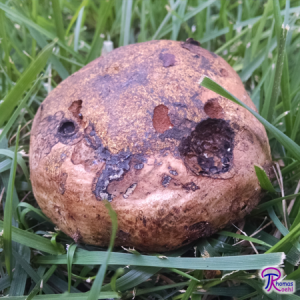
Pisolithus arrhizus can grow just about anywhere. This one was growing in the thin strip of grass between the sidewalk and the road and was probably associated with a nearby oak tree.
One of the most significant aspects of P. arrhizus is its exceptional ability to form ectomycorrhizas. The Dyeball is one of the most generous mycorrhizal partners, so foresters and others often inoculate tree seedlings with P. arrhizus spores to give the plants an early growth boost. There are many other mushrooms that can be used for the same purpose, but P. arrhizus the easiest because it forms mycorrhizas with a wide variety of tree species.,,, The fungus is known to partner with over 40 species of trees, including various species of pine, birch, oak, Douglas-Fir, hemlock, willow, and poplar. The Dyeball is also useful in reclamation and reforestation efforts because it can grow in very poor soils with high acidity, heavy metal concentration, temperatures, and likelihood of drought.,
Although P. arrhizus does not associate with eucalyptus, there are other species of Pisolithus that do. If you find a mushroom under eucalyptus matching the above description, it’s probably some species of Pisolitus that was imported from Australia.
Краснокнижный вид
Pisolithus arhizus в Красной книге Республики Бурятия
Классификация: Основные группы > Fungi, lichens and fungus-like organisms (Грибы, лишайники и грибоподобные организмы) > Basidiomycota (Базидиальные) > Agaricomycetes > Boletales (Болетовые) > Sclerodermataceae (Склеродермовые) > Pisolithus (Пизолитус)
| Таксон | Pisolithus arhizus (Пизолитус бескорневой) |
| Русское название | Пизолитус бескорневой |
Правовой статус
| Документ | Приложение | Дата | Номер таксона | Указан как | Статус | Категория | Дополнительно |
|---|---|---|---|---|---|---|---|
| Об утверждении Перечня (списка) редких и исчезающих видов растений и грибов Республики Бурятия, подлежащих занесению во второе издание Красной книги Республики Бурятия | 2004-08-10 | добавлен |
Описания
| Издание | Абашеев РЮ, Азовский МГ, Алексеев СС и др (2013) Красная книга Республики Бурятия: Редкие и находящиеся под угрозой исчезновения виды животных, растений и грибов. Улан-Удэ: Изд-во БНЦ СО РАН 3 688 PDF Внешняя ссылка |
| Таксон указан как | Pisolithus arhizus |
| Категория | 3 (NT): Редкий вид с дизъюнктивным ареалом. |
| Морфологическое описание | Плодовые тела булавовидные, реже грушевидные. Над поверхностью почвы выступает верхняя, округлая или неправильно шаровидная, спороносная часть 2-11 см в диаметре. Ножка мощная, 1-8 см в диаметре, у основания обычно разветвленная, покрытая слоем черной слизи, погружена в песок на глубину до 25 см. Перидий тонкий, гладкий, очень ломкий, охристо-желтый, красновато-оливковый или темно-коричневый. Глеба белая или желтоватая, с возрастом коричневеет, распадается на небольшое число неровных, гороховидных, угловатых, сначала серно-желтых, а потом коричневых перидиол. Споры шаровидные, бородавчатые, охристые или коричневые, 7-10 мкм в диаметре. |
| Распространение | В Бурятии известны всего две находки, обе на восточном побережье оз. Байкал (устье р. Баргузин и перешеек п-ва Святой Нос, Баргузинский р-н) . Ареал вида космополитный: Европа, Азия, Северная и Центральная Америка, Австралия, но везде крайне редок . |
| Образ жизни | Сыпучие пески, дюны, по берегам рек или морей у одиночных пальм, сосен или, в нашем случае, кедрового стланика, с которыми образует микоризу. Плодовые тела образуются на глубине 15-25 см под землей и слабо заметны даже в зрелом состоянии, когда верхняя часть глебы появляется над поверхностью песка. |
| Численность | Низкая численность обусловлена, вероятно, биологией вида. Единственная известная в Восточной Сибири популяция может исчезнуть от любых, в том числе и случайных, причин. |
| Охранные меры | Охраняется на территории Забайкальского национального парка. Необходима грамотная природоохранная пропаганда и регулирование рекреационных нагрузок на пляжах восточного побережья озера Байкал. |
| Ссылки | 1. Петров, 2013; 2. Петров, 2002д; 3. Сосин, 1973; 4. Julich, 1984; 5. Cortecuisse, 1994. |
| Составители | А.Н. Петров |
Сезон и местообитание гриба
Раньше гриб Пизолитус красильный (Pisolíthus tinctorius) относили к категории космополитов, и его можно было встретить практически везде, кроме регионов, расположенных за Полярным кругом. Сейчас осуществляется пересмотр границ обитания этого гриба, поскольку некоторые его подвиды, произрастающие, например, на территории Южного полушария и тропиков, отнесены к отдельным разновидностям. На основании этой информации можно сказать, что пизолитус красильный встречается на территории Голарктики, а вот его разновидности, встречающиеся в Южной Африке и Азии, Центральной Африки, Австралии, Новой Зеландии, принадлежат, скорее всего, к родственным типам. На территории России пизолитус красильный можно увидеть в Западной Сибири, на территории дальнего Востока и на Кавказе. Период наиболее активного плодоношения приходится на лето и начало осени. Произрастает или одиночно или группами небольшого размера.
Красильный пизолитус произрастает преимущественно на кислых и бедных почвах, на лесных вырубках, постепенно зарастающих, на зеленеющих отвалах и постепенно зарастающих карьерах. Однако эти грибы никогда нельзя увидеть на грунтах известнякового типа. Крайне редко он произрастает и в лесах, которые практически не тронуты человеком. Может образовывать микоризу с берёзами и деревьями хвойных пород. Является микоризообразователем с эвкалиптами, тополями и дубами.
Photos of this mushroom from East and Central Texas
Dyeball mushroom (Pisolithus arhizus, Pisolithus tinctorius) taken from a lawn on campus of Texas A and M University. College Station, Texas, September 13, 2018
Horse dung fungus (dyeball mushroom, Pisolithus arhizus, Pisolithus tinctorius) taken from a lawn on campus of Texas A and M University. College Station, Texas, September 13, 2018
Dissectedorse dung fungus (dyeball mushroom, Pisolithus arhizus, Pisolithus tinctorius) taken from a lawn on campus of Texas A and M University. College Station, Texas, September 13, 2018
Dyeball mushroom (Pisolithus arhizus, Pisolithus tinctorius) on a sandy lawn in Lick Creek Park. College Station, Texas, September 18, 2018Iron Bridge Trail, College Station, TX 77845, USA
Dyeball mushroom (Pisolithus arhizus, Pisolithus tinctorius) in Lick Creek Park. College Station, Texas, September 21, 2018Iron Bridge Trail, College Station, TX 77845, USA
Close up of dyeball mushroom (Pisolithus arhizus, Pisolithus tinctorius) in Lick Creek Park. College Station, Texas, September 21, 2018Iron Bridge Trail, College Station, TX 77845, USA
Tuff puffball mushrooms (Scleroderma texense) and dyeball fungus (Pisolithus arhizus, Pisolithus tinctorius) on a flowerbed with mulch at Spence Street on campus of Texas A and M University. College Station, Texas, October 1, 2018Richardson Petroleum Engineer Bldg, 245 Spence St, College Station, TX 77840, USA
Dyeball mushroom (Pisolithus arhizus, Pisolithus tinctorius) in Bastrop State Park. Bastrop, Texas, October 14, 2018Bastrop State Park, 100 Park Road 1A, Bastrop, TX 78602, USA
Dyeball mushrooms (Pisolithus arhizus, Pisolithus tinctorius) on wood chips in Bastrop State Park. Bastrop, Texas, October 14, 2018321 Harmon Rd, Bastrop, TX 78602, USA
Dyeball mushroom (Pisolithus arhizus, Pisolithus tinctorius) taken from a lawn on campus of Texas A and M University. College Station, Texas, September 18, 2019
Dyeball mushrooms (Pisolithus arhizus) in Old Baylor Park. Independence, Texas, March 15, 20218488 Old Baylor College Rd, Brenham, TX 77833, USA
Cross section of dyeball mushrooms (Pisolithus arhizus) among lupinus in Old Baylor Park. Independence, Texas, March 15, 20218488 Old Baylor College Rd, Brenham, TX 77833, USA
Dissected dyeball mushrooms (Pisolithus arhizus) in Old Baylor Park. Independence, Texas, March 15, 20218488 Old Baylor College Rd, Brenham, TX 77833, USA
Close-up of a broken dyeball mushroom (Pisolithus arhizus) in Lick Creek Park. College Station, Texas, June 30, 2021Yaupon Loop, College Station, TX 77845, USA
Dyeball mushrooms (Pisolithus arhizus) on a pipeline right of way in Lick Creek Park. College Station, Texas, June 30, 2021Yaupon Loop, College Station, TX 77845, USA
Cross section of dyeball mushrooms (Pisolithus arhizus) in Lick Creek Park. College Station, Texas, June 30, 2021Yaupon Loop, College Station, TX 77845, USA
Dyeball mushroom (Pisolithus arhizus) collected from the university golf course. College Station, Texas, January 17, 2022
Texture of dyeball mushroom (Pisolithus arhizus) from a lawn of the university golf course. College Station, Texas, January 17, 2022
Dyeball mushrooms (Pisolithus arhizus) on Stubblefield section of Lone Star hiking trail north from Trailhead No. 6 in Sam Houston National Forest. Texas, September 11, 2022Lone Star Hiking Trail, Walker County, Texas, United States
Cross section of dyeball mushrooms (Pisolithus arhizus) on Stubblefield section of Lone Star hiking trail north from Trailhead No. 6 in Sam Houston National Forest. Texas, September 11, 2022Lone Star Hiking Trail, Walker County, Texas, United States
Spores of dyeball mushrooms (Pisolithus arhizus) collected a day before on Stubblefield section of Lone Star hiking trail in Sam Houston National Forest. Texas, September 12, 2022
Spores of a mature dyeball mushroom (Pisolithus arhizus) from a pipeline (no picture taken), collected on Caney Creek Trail (Little Lake Creek Loop Trail) in Sam Houston National Forest north from Montgomery. Texas, September 17, 2022
